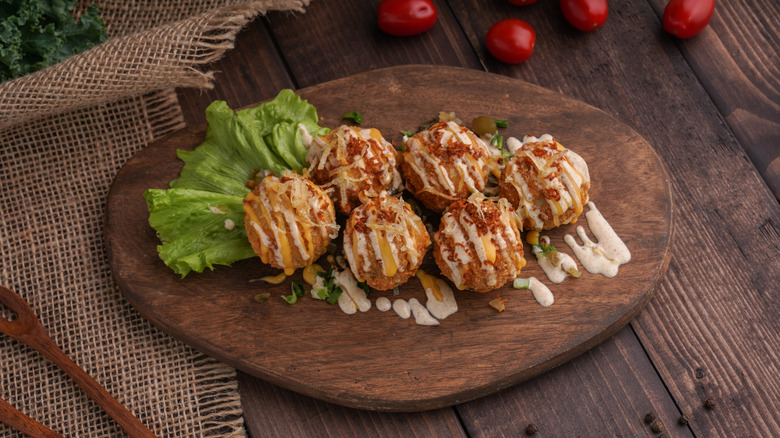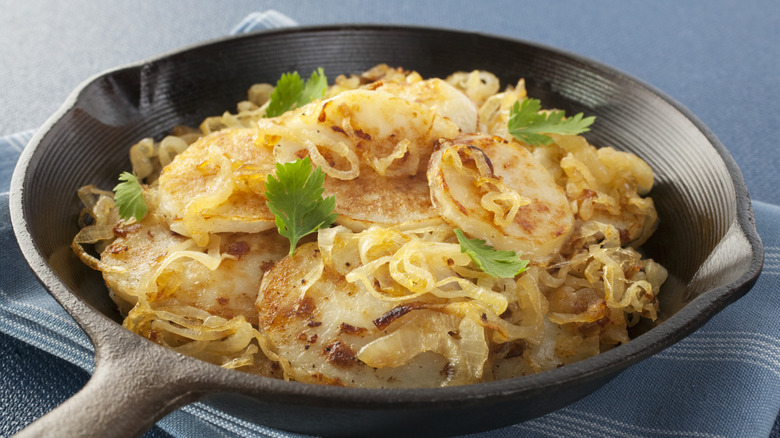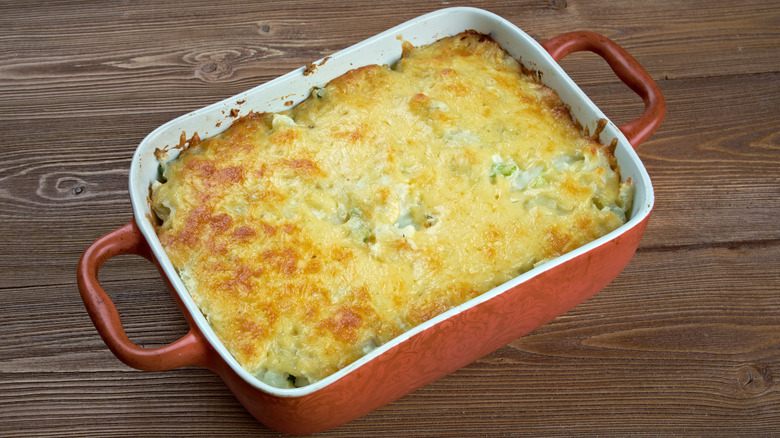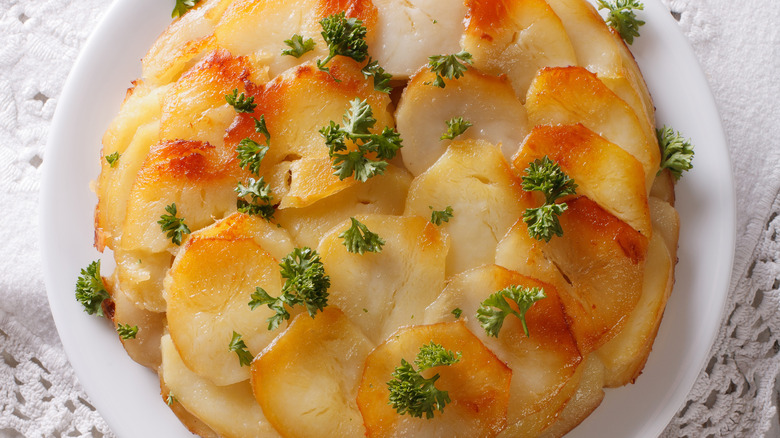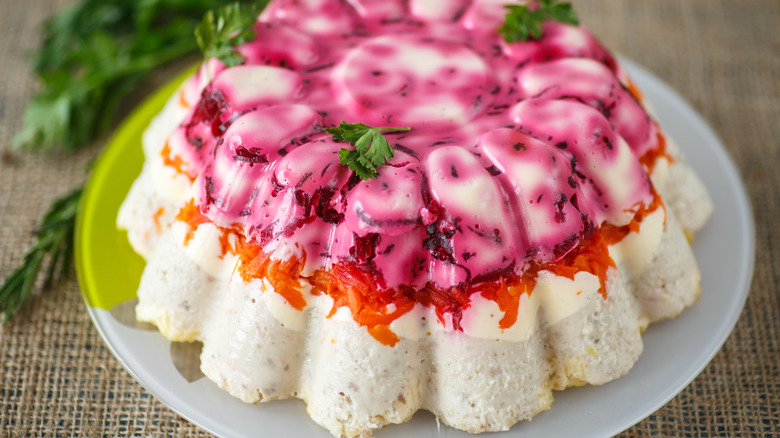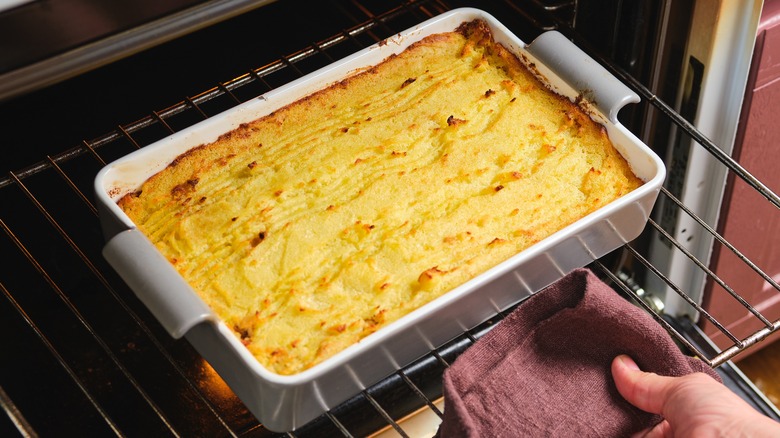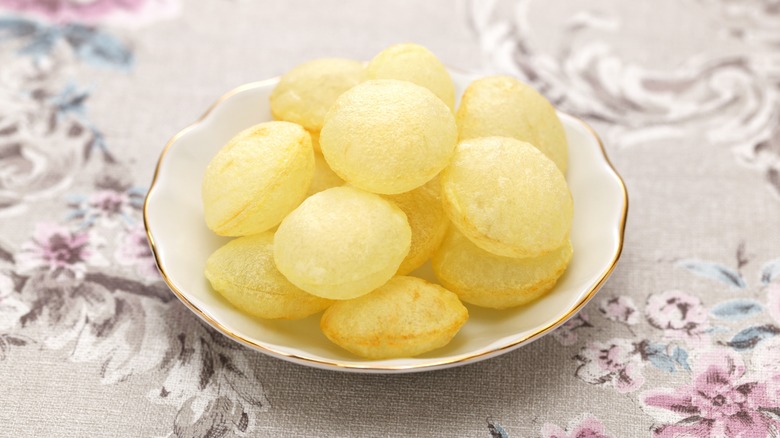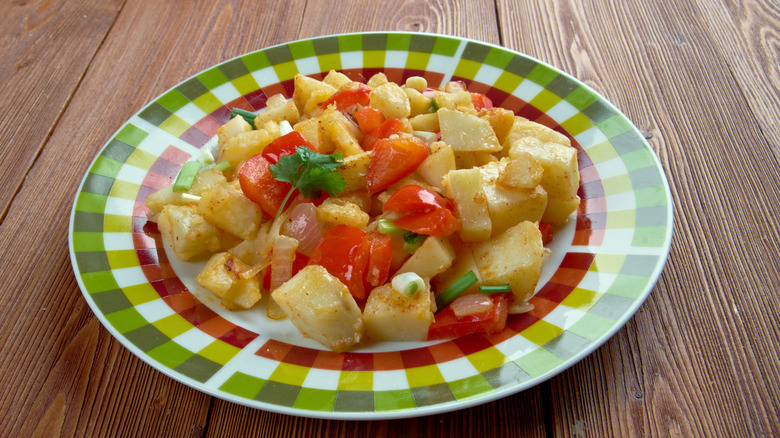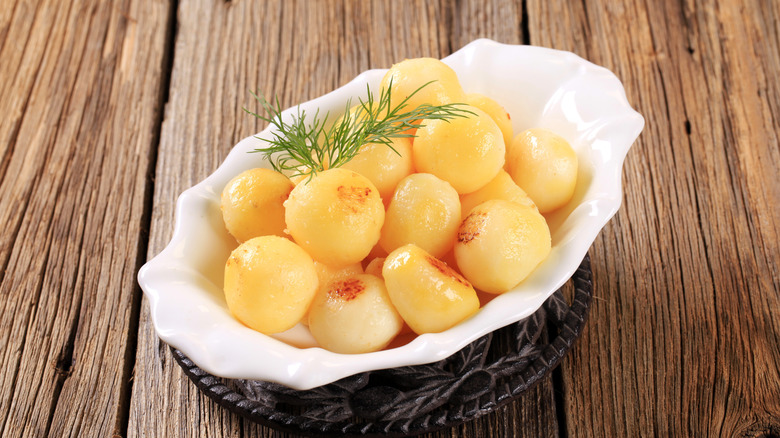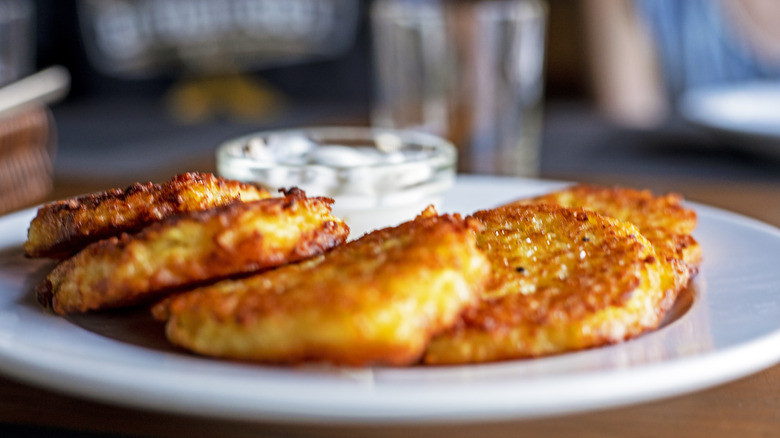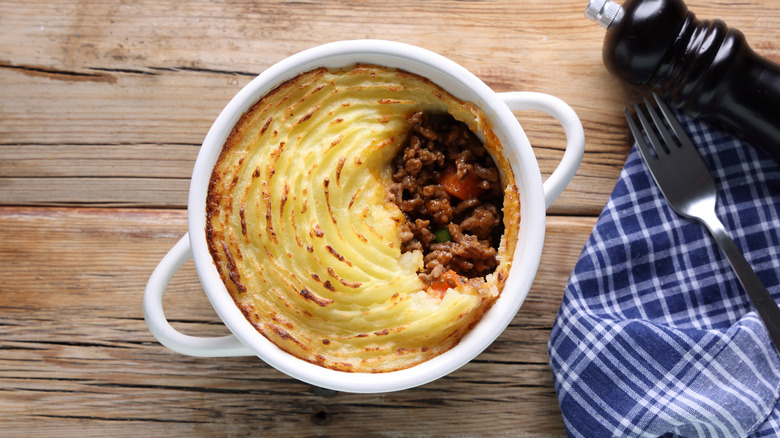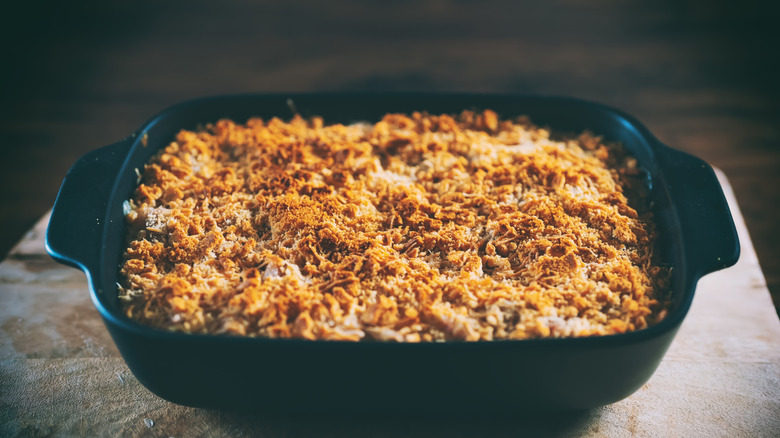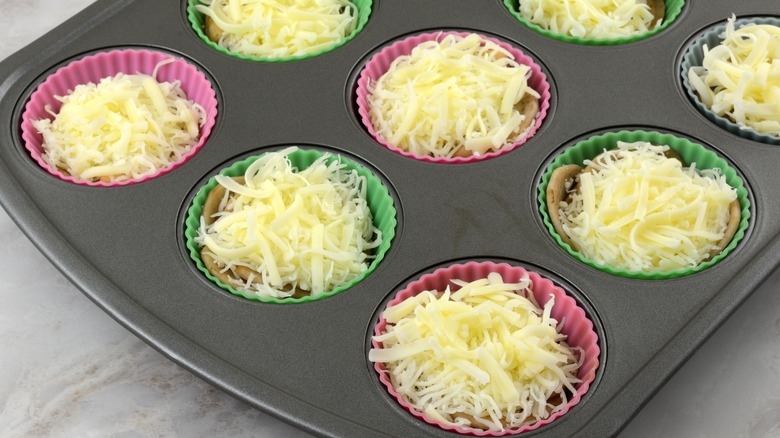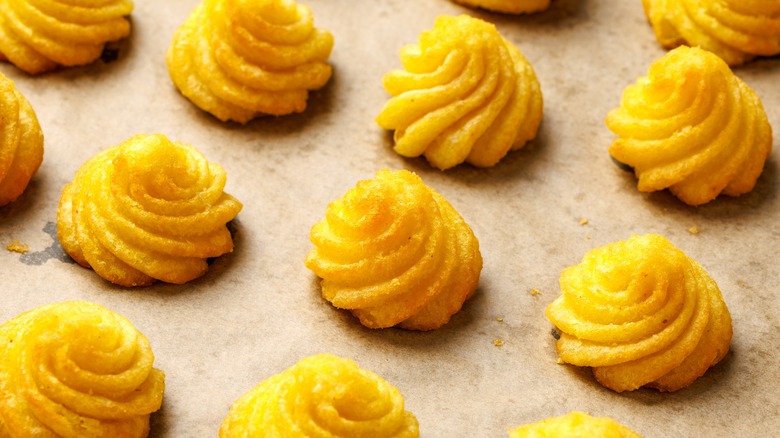Old-School Potato Dishes You Rarely See Anymore
Who doesn't love a potato? Roasted, baked, fried, mashed — you probably have your favorite ways to cook them. But before you dig out your go-to scalloped potato recipe or have yet another side of french fries, you might want to learn more about some old-school potato dishes that you rarely see anymore.
Some of them have fallen out of favor due to changing tastes or because they were too fussy and time-consuming for everyday dinners, but many simply faded away amongst all the many options out there. For instance, there's no real reason why Lyonnaise potatoes are less popular than other fried potatoes — that's just the way it worked out. Whether you're interested in food history or want to make some old-school dishes, you might want to learn more about these ones.
These vintage potato recipes aren't all that popular these days, but that doesn't mean they should be totally lost to time. Some of them absolutely deserve a comeback — and you might be the one to make them a thing again. Maybe it's time to dig out your grandparents' cookbooks and give them a whirl.
Lyonnaise potatoes
Lyonnaise potatoes date all the way back to the 19th century, but they're not something you'll find on many menus or cooked in American homes today. Originating in Lyon, France, these potatoes aren't flashy, but they're totally delicious. It's the kind of vintage dish that feels timeless because you wouldn't be surprised if it was contemporary.
They're essentially fried, sliced potatoes served with caramelized onions. To get a crisp exterior and fluffy interior, the potato slices must be parboiled before they're fried. Not so much that they fall apart but enough to give you a perfectly cooked middle when they're done. The slices are then fried in butter, clarified butter, or a combination of butter and oil until they're perfectly crisp on each side.
In another pan, you caramelize onions. If you're not sure how to do this, we have some tips for making perfect caramelized onions. Once all the potato slices are fried and the onions are caramelized, you combine them and serve. This dish is focused around just two simple ingredients — potatoes and onions — but manages to be one of the tastiest dishes out there. This one is definitely a vintage dish that needs to make a return.
Rumbledethumps
Rumbledethumps is a bit like a Scottish version of bubble and squeak. It's the perfect way to use up leftover mashed potato and cabbage (or other greens you have lying around). Even across the pond, these kinds of classic dishes are falling out of favor for trendier options, but we think they still deserve a place on the table — especially as folks are trying to reduce food waste.
Usually, to make this dish, you'd start with any leftover mashed potatoes and greens that you have. However, if you want to make it from scratch, you can use your favorite mashed potato recipe and choose leafy greens to cook in butter until soft. Optionally, you can fry an onion for some extra flavor. Mix together your potatoes, greens, and onions (if you're going that route). Then, put the mixture in a baking dish, cover it with cheddar, and cook until the cheese is golden brown.
Not only does it taste great, you can feel good about the fact you've used up leftovers to make it. Plus, it's versatile enough to serve with almost any dish where you'd classically have potatoes as a side.
Pommes Anna
Pommes Anna is one of those vintage dishes that proves how classy potatoes can be with a little care and a lot of butter. This French classic dates back to the mid-19th century and is often credited to Adolphe Dugléré, a chef at Café Anglais in Paris. It consists of thinly sliced potatoes layered with melted butter and baked until crisp, golden, and impossibly tender inside.
You have to be precise to make the perfect pommes Anna. The potatoes must be sliced uniformly thin — about 2 millimeters or 1/12 inch — ideally with a mandoline. Each slice is brushed generously with melted butter before being layered in a circular pattern inside a heavy ovenproof pan. Once assembled, the potatoes are baked under weight to help them compress and develop that signature crisp crust.
When done right, the finished dish can be unmolded like a cake, revealing beautiful concentric layers. The outside is crisp, while the inside is buttery and soft. Though once a showpiece of fine dining, pommes Anna has largely disappeared from home kitchens. It's a shame, as it really shows what you can do with just simple ingredients.
Molded potato salad
Here's one from the archives that we may not particularly want back. Molded potato salad dates back to the mid-20th century, when a surprising number of dishes came molded in Jello. This one is essentially a standard potato salad with a gelatin "glue" to keep it in shape.
The potato salad part is much as you'd expect — pieces of cooked potato mixed with mayonnaise and a selection of extras. Recipes can vary but can contain white onions, green onions, herbs, olives, celery, and hard-boiled eggs. The salad part is made as normal and then set in a mold with clear gelatin. The flavor isn't hugely different than a regular potato salad would be, but it obviously has a more gelatinous texture.
Jello salad isn't as popular today as it once was for many reasons. But a big one is just changing tastes — these days, eating a salad suspended inside gelatin just sounds odd (and for some, unappetizing). So, it's not about to become a newfound crowd-pleaser, but it is an interesting part of culinary history.
Potato filling
A Pennsylvania Dutch classic, potato filling is a bit like a mixture between mashed potatoes and stuffing. It was once a Thanksgiving favorite, it has become less popular over the years and now it's rarely seen. It's a dense mashed potato that's been thickened with bread and given flavor from onion, celery, and plenty of butter.
You should start with starchy potatoes, as they break down and bind better than waxy varieties. Cook them until tender, drain well, and mash with butter and milk or cream so the texture is rich but not gluey. Separately, slowly cook onions and celery until they turn sweet and soft. Fold the mixture through the mash along with cubes of toasted bread, and another helping of butter. Then, press everything into a buttered pan, scatter a few more knobs of butter on top, and bake.
The resulting dish is pretty dense and heavy, but in a good way. It's naturally a great Thanksgiving side, but you shouldn't let that stop you from making it at other times of year, as well. It's one of those vintage dishes that needs more recognition than it gets.
Pommes soufflées
Pommes soufflées are like French fries that are just showing off. These paper-thin discs of spud puff into light, hollow pillows when fried correctly. To get them right, you need very thin slices, dried of excess starch and moisture. Then, they must be deep fried to get the right results. You end up with an astoundingly crisp exterior and a hollow interior. You can serve them with fancy toppings or sauces. They're fiddly, yes, so we can see why they're not more popular these days when you easily can buy good fries from the freezer and put them in the oven. But these are next level.
To make them, use a firm, starchy potato and slice on a mandoline so every round is the same thickness. Rinse and soak the slices to wash away surface starch, dry them thoroughly, and sprinkle the tops with cornstarch. You then use egg to stick the cornstarch sides of two pieces together to create double layered pieces. Each of these pieces you then turn into a uniform circle with a cookie cutter.
Next up is the frying stage. Don't overcrowd the fryer: The slices need room to puff. Afterwards, drain your potato pillows briefly on paper to keep them crisp. When they work, pommes soufflées are real showstoppers. When you don't puff, you've at least whipped up some tasty homemade chips.
Potatoes O'Brien
Potatoes O'Brien is the vintage classic that was once in every diner, but is now a rarity. This dish consists of cubed potatoes tossed with diced red and green bell peppers and onions, pan-fried until the edges are brown and slightly caramelized. It likely dates back to the early 1900s, though its exact origins are unclear. What we do know is that it became a breakfast staple for a time, before falling into relative obscurity.
It's easy to make at home if you want to give it a try. For best results, cut the potatoes into even dice of about a 1/2 inch so everything cooks uniformly. You can parboil the cubes briefly to speed things along and ensure a tender center, or start raw and cook longer before adding the other ingredients. When the potatoes are tender, you can add the peppers and onions and keep going until everything is done. Use a heavy skillet and give the potatoes plenty of space. Crowding the pan makes the potatoes steam rather than brown. This is a solid potato hash that doesn't deserve to disappear.
Parisian potatoes
Parisian potatoes — or pommes Parisienne, if you're feeling fancy — are simple to make with the right gear but look and taste like haute cuisine. The name comes from a little tool, the Parisienne scoop, which is used to cut potatoes into neat spheres. After scooping, the balls are usually parboiled or simmered gently until just tender, then finished in a skillet with plenty of butter (or a butter-and-oil mix) until they're golden and crispy. This vintage recipe isn't one you see around much anymore, but we wish it was everywhere.
Because of their small size and even shape, Parisian potatoes brown beautifully and cook through without fuss. The main tricky thing is using the Parisienne scoop (or melon baller) to turn your potatoes into perfect spheres. You can't scoop them out of the potato too close together or they'll end up misshapen. This can leave you with waste, but any leftover raw potato can be turned into mash. But, aside from the shaping, it's much like making any fried potato dish. So, yes, it's fiddly, but you don't need to be a trained chef to make them well.
Potato pancakes
Depending on geography, potato pancakes go by many names, but the technique is broadly the same: Grate starchy potatoes, squeeze out as much moisture as you can, mix with grated onion, an egg or flour as a binder, then shallow-fry until deeply brown and crunchy. While they're still very popular in some cultures' cuisine — such as traditional Jewish latkes or Ukrainian deruny — this isn't the kind of side dish you'll find on an average menu. In our opinion, the world is worse off for that.
These pancakes are wonderfully flexible. Serve them sweet with apple sauce, savory with sour cream and chives, or as a side to a larger meal, be it breakfast, lunch, or dinner. For the best texture, use a high-starch potato, press out liquid in a clean towel, and don't overcrowd the pan when you cook them. They've been a holiday staple in some cultures and an everyday comfort food in others, and they deserve a place in your repertoire. They're quick to make, forgiving, and incredibly tasty.
WWI potato pie
During the World War I, meat and other staples were scarce in many places, so cooks learned to stretch small amounts of protein with potatoes. This WWI potato pie was published in a military cookbook. Many young men who went off to war had no idea how to cook, so it was designed to be easy enough for even a complete novice to make for their fellow soldiers using simple ingredients they would have had access to.
It consists of seasoned canned corned beef topped with mashed potatoes and baked. It's similar to a shepherd's pie recipe but even easier to make (with fewer ingredients). Admittedly, this might be a dish that's best left in the past. That said, it has a lot of potential to be modernized. Don't fancy corned beef? Use other meat or even make it veggie by using brown lentils or tempeh. Add herbs and spices to make it more flavorful or grate cheese over the top before baking. There are all kinds of ways to bring it into the 21st century.
Delmonico potatoes
Created at Delmonico's Restaurant in the early 19th century, this dish soon became popular. With their rich, creamy sauce, it's no surprise that Delmonico potatoes were a hit. At first, they were only found in this fine dining establishment. However, by the 1950s, they had trickled down and were popular enough to be found in diners and family restaurants — and were even served on airlines. However, these days, they're a vintage side that's all but disappeared.
To make it, you cube and parboil potatoes before mixing them into a homemade béchamel sauce, dumping them in a buttered baking dish, covering them in cheese and breadcrumbs, and baking until the cheese is melted and the breadcrumbs golden. Using a fairly mild cheese like Swiss or Gruyere is ideal. It's richer than you might want from a side dish for an average dinner, but for a special occasion, this is one old-school potato recipe that you might want to revisit. It's a bit like a less elegant version of dauphinoise potatoes or scalloped potatoes, but no less delicious.
Potato timbales
Molded and served individually, potato timbales are seen as fussy these days, which might be why they've fallen out of favor. But they can add a bit of class to any meals that you might usually serve with potatoes, so we think there's still room for them in modern day cuisine. It would be a shame to lose this delightful side dish to the annals of history.
There's no set way to make potato timbales, but they generally start with mashed or riced potatoes. It's even possible to use leftover mashed potatoes if you want to be frugal or eco-friendly. They're often mixed with cheese for flavor and eggs or breadcrumbs to act as binders. The mixture is divided into muffin tins or ramekins and baked until golden and set. Unmolded, they can be served alongside all kinds of proteins and vegetables. They're not the simplest things to make but they're worth the effort.
Duchess potatoes
It's a mystery why duchess potatoes ever went out of style. This elegant old-fashioned dish was a mainstay of 19th-century French haute cuisine, attributed to the legendary chef Marie-Antoine Carême. They became a staple of grand hotel dining and formal dinners throughout the early 20th century, looking and tasting like something you'd expect from a meal you've paid a lot of money for.
Essentially, duchess potatoes are just enriched mashed potatoes, but it's all in the details. You start with starchy potatoes, boiled and mashed until completely smooth. Then you mix in egg yolks, butter, cream or milk, and a hint of nutmeg or white pepper for subtle warmth. The yolks give the mash its rich, custardy texture and help it hold its shape when baked. The mixture is piped into decorative swirls or rosettes onto a baking sheet and brushed with egg wash before baking until lightly browned at the peaks.
Crisp on the outside and soft inside, they're a perfect example of classic French refinement applied to comfort food. They're mashed potatoes with a fancy flourish that deserves a comeback on modern tables. It would be practically a crime to leave them in the past.
